
It's about how to be a professional English reader.
- Subject:
- Languages
- Material Type:
- Student Guide
- Author:
- Samih Alkhouly
- Date Added:
- 04/25/2023

It's about how to be a professional English reader.

Students will examine how patriotism comes in many forms through an analysis of the short film "Patriotism and Protest." In the film, experts and Minidoka survivors highlight how the infamous "loyalty questionnaire" during WWII divided the Japanese American community.

Students will examine how news outlets and government propaganda shaped war hysteria and racism against Japanese Americans during WWII. In the short film, "Power of the Press," students will learn about the pre-war racism against Asian Americans and how community allyship can have a profound effect in combating propaganda.

Students will examine how language shapes public perception through an analysis of the short film "Power of Words." In the film, experts highlight the various euphemisms used by the US government to describe the WWII incarceration of Japanese Americans and how the language used to describe this event did not match the reality.

Students will examine the responsibility of citizens through an analysis of the short film "Standing Up for Others." In the film, Japanese Americans draw parallels between their experience during World War II and the experiences of Muslim Americans and asylum-seeking migrant children.
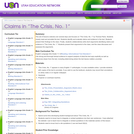
This set of lessons extends over several days and focuses on "The Crisis, No. 1" by Thomas Paine. Students closely read and annotate the text. Students identify and evaluate claims and evidence in the text. Students present their findings to the class. Finally, students collaboratively write short arguments identifying claims and evidence in "The Crisis, No. 1." Students present their arguments to the class, and the class discusses and assesses the arguments.
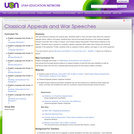
This set of lessons extends over several days. Students watch a Prezi and take notes about the classical appeals (ethos, pathos, and logos). Students then read and annotate (focusing on the classical appeals) Winston Churchill's "Be Ye Men of Valour" and Franklin Delano Roosevelt's "Pearl Harbor Address to the Nation." Students work in groups to complete a graphic organizer which helps them analyze the classical appeals in the speeches. Finally, students write an analysis of ethos, pathos, and logos in one of the speeches.

This unit plan was designed in order to instruct students in the Kittitas Valley about the contributions and perspectives of the Kittitas Band of the Yakama Nation. This unit plan has students use primary and secondary sources, inquiry, videos and lecture to plan and conduct an oral history interview with a Kittitas Band member. If tribal members of the Kittitas are not avaiable for interview, there is a sample video of an interview with Kittitas member Allen Aronica. Students can use this video instead of conducting an oral history interview for the final lesson.

The 11th grade learning experience consists of 7 mostly month-long units aligned to the Common Core State Standards, with available course material for teachers and students easily accessible online. Over the course of the year there is a steady progression in text complexity levels, sophistication of writing tasks, speaking and listening activities, and increased opportunities for independent and collaborative work. Rubrics and student models accompany many writing assignments.Throughout the 11th grade year, in addition to the Common Read texts that the whole class reads together, students each select an Independent Reading book and engage with peers in group Book Talks. Students move from learning the class rituals and routines and genre features of argument writing in Unit 11.1 to learning about narrative and informational genres in Unit 11.2: The American Short Story. Teacher resources provide additional materials to support each unit.

In this unit, students will take a look at the historical vision of the American Dream as put together by our Founding Fathers. They will be asked: How, if at all, has this dream changed? Is this dream your dream? First students will participate in an American Dream Convention, acting as a particular historical figure arguing for his or her vision of the American Dream, and then they will write an argument laying out and defending their personal view of what the American Dream should be.
ACCOMPLISHMENTS
Students read and annotate closely one of the documents that they feel expresses the American Dream.
Students participate in an American Dream Convention, acting as a particular historical figure arguing his or her vision of the American Dream.
Students write a paper, taking into consideration the different points of view in the documents read, answering the question “What is the American Dream now?”
Students write their own argument describing and defending their vision of what the American Dream should be.
GUIDING QUESTIONS
These questions are a guide to stimulate thinking, discussion, and writing on the themes and ideas in the unit. For complete and thoughtful answers and for meaningful discussions, students must use evidence based on careful reading of the texts.
What has been the historical vision of the American Dream?
What should the American Dream be? (What should we as individuals and as a nation aspire to?)
How would women, former slaves, and other disenfranchised groups living during the time these documents were written respond to them?
BENCHMARK ASSESSMENT: Cold Read
During this unit, on a day of your choosing, we recommend you administer a Cold Read to assess students’ reading comprehension. For this assessment, students read a text they have never seen before and then respond to multiple-choice and constructed-response questions. The assessment is not included in this course materials.

The 12th grade learning experience consists of 7 mostly month-long units aligned to the Common Core State Standards, with available course material for teachers and students easily accessible online. Over the course of the year there is a steady progression in text complexity levels, sophistication of writing tasks, speaking and listening activities, and increased opportunities for independent and collaborative work. Rubrics and student models accompany many writing assignments.Throughout the 12th grade year, in addition to the Common Read texts that the whole class reads together, students each select an Independent Reading book and engage with peers in group Book Talks. Language study is embedded in every 12th grade unit as students use annotation to closely review aspects of each text. Teacher resources provide additional materials to support each unit.

Who decides who among us is civilized? What rules should govern immigration into the United States? Whom should we let in? Keep out? What should we do about political refugees or children without papers? What if they would be a drain on our economy?
ACCOMPLISHMENTS
Students read William Shakespeare’s play The Tempest and write a short argument about who in the play is truly civilized.
Students participate in a mock trial in which they argue for or against granting asylum to a teenage refugee, and then they write arguments in favor of granting asylum to one refugee and against granting it to another.
Students read an Independent Reading text and write an informational essay about a global issue and how that relates to their book.
GUIDING QUESTIONS
These questions are a guide to stimulate thinking, discussion, and writing on the themes and ideas in the unit. For complete and thoughtful answers and for meaningful discussions, students must use evidence based on careful reading of the texts.
What role do national identity, custom, religion, and other locally held beliefs play in a world increasingly characterized by globalization?
How does Shakespeare’s view of human rights compare with that in the Universal Declaration of Human Rights?
Who is civilized? Who decides what civilization is or how it’s defined?
How do we behave toward and acknowledge those whose culture is different from our own?

In this short unit, students will spend three lessons exploring some of Abraham Lincoln's speeches. Students will explore Lincoln's themes and consider how they address the issues of his time, and they'll analyze the literary and rhetorical devices he used to express his ideas.

The laws that govern and the social norms that regulate society are not always fair, legal, moral, or ethical. What is a person to do about all this injustice? What are the hazards of righting injustices or changing social norms? And what are the dangers of doing nothing?
ACCOMPLISHMENTS
Students read and annotate Antigone, “Letter from a Birmingham Jail,” and Pygmalion.
Students write a literary analysis showing the effect of social class or the law on a character’s life.
GUIDING QUESTIONS
These questions are a guide to stimulate thinking, discussion, and writing on the themes and ideas in the unit. For complete and thoughtful answers and for meaningful discussions, students must use evidence based on careful reading of the texts.
How do social class and legal institutions shape literary characters’ lives (and presumably our lives)?
How does social class affect a person in dealing with the law (protect a person, hurt a person)?
How is social class determined in America and in other places in the world?
BENCHMARK ASSESSMENT: Cold Read
During this unit, on a day of your choosing, we recommend you administer a Cold Read to assess students’ reading comprehension. For this assessment, students read a text they have never seen before and then respond to multiple-choice and constructed-response questions. The assessment is not included in this course materials.
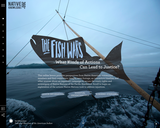
This online lesson provides perspectives from Native American community members and their supporters, images, news footage, an interactive timeline, and other sources about an important campaign to secure the treaty rights and sovereignty of Native Nations of the Pacific Northwest. Scroll to begin an exploration of the actions Native Nations took to address injustices.
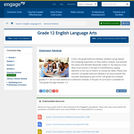
In this 12th grade Extension Module, students can go deeper into analyzing arguments, as they outline, analyze, and evaluate the claims that Michelle Alexander makes in|The New Jim Crow: Mass Incarceration in the Age of Colorblindness, paying attention to her use of rhetoric to convey her ideas. Please note that this 12th grade Extension Module is an extra module that has been developed as part of the 12th grade ELA modules; grades 9-11 do not have additional or extension modules. A full year of curriculum is available for 12th grade through modules 1-4.
Find the rest of the EngageNY ELA resources at https://archive.org/details/engageny-ela-archive .
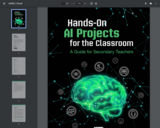
This guide provides student-driven projects that can directly teach subject area standards in tandem with foundational understandings of what AI is, how it works, and how it impacts society. Several key approaches were taken into consideration in the design of these projects. Understanding these approaches will support both your understanding and implementation of the projects in this guide, as well as your own work to design further activities that integrate AI education into your curriculum.
Project 1: AI Chatbots
Project 2: Developing a Critical Eye
Project 3: Using AI to Solve Environmental Problems
Project 4: Laws for AI
Visit the ISTE website with all the free practical guides for engaging students in AI creation: https://www.iste.org/areas-of-focus/AI-in-education
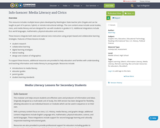
This resource includes multiple lesson plans developed by Washington State teacher John Zingale and can be taught as part of in-person, hybrid, or remote instructional settings. The core content areas include social studies, civics, and media literacy and are designed for use with students in grades 6-12. Additional integrations include ELA, world languages, mathematics, physical education and science. These lessons integrate both state and national civics instruction using project-based and collaborative learning strategies. Features of these lessons include:student researchcollaborative learningdigital learning strategieslateral readingdesign and creation of infographicsTo support these lessons, additional resources are provided to help educators and families with understanding and teaching information and media literacy to young people. Resources include:introductions to media literacyeducator guidesparent guidesstudent learning standards
![Lenses of Vietnam: Protest in a Democracy [Inquiry Design Model (IDM) Unit Plan]](https://img.oercommons.org/160x134/oercommons/media/courseware/lesson/image/22Photograph_of_a_Female_Demonstrator_Offering_a_Flower_to_a_Military_Police_Officer22_by_Albert_R._Simpson_uOQkEc8.gif)
This inquiry takes students through an analysis and evaluation of the Compelling Question “Is protest important in a democracy?” using the Vietnam War as a lens to approach the topic. To accomplish this, students will become more media literate through evaluating sources, biases, perspectives, and the goals of creating media. Throughout the inquiry, students will engage in activities designed to promote and develop media literacy while analzying the Compelling Question and learning about the historical protests of the Vietnam Era.This inquiry is expected to take two weeks (10 periods) to complete: one 45-minute class period to stage the question, introduce the inquiry, and to review media literacy; two 45-minute class periods for each of the three supporting questions; and then three 45-minute class periods for students to write and research their argumentative thesis. If students are as of yet less familiar with media literacy, the instructor should add at least another class period, or more, introducing them more fully to this.The full unit, along with all materials and resources, is available as a PDF attachment.

Local government is the government of people’s daily lives. It is your local government that you will interact with most throughout your daily life. In this seminar, you will learn about the role of local government in a community. By the end of this seminar, you will be able to discuss how local government and community members work together. You will be able to compare the structure of local government as a whole to the structure of the government in your community.Standards5.1.4 C - Explain the principles and ideals shaping local and state government.